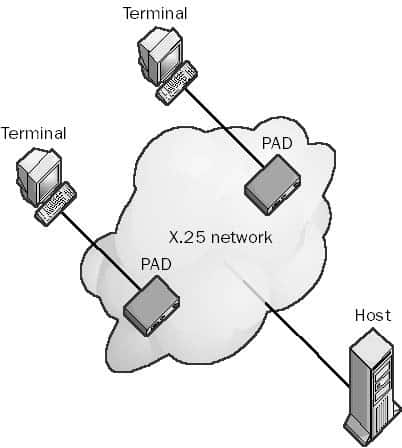Definition of packet assembler/disassembler (PAD) in The Network Encyclopedia.
What is PAD (packet assembler-disassembler)?
PAD, stands for packet assembler-disassembler, is a telecommunications device that breaks a data stream into individual packets and formats the packet headers for asynchronous transmission over an X.25 network. It also accepts packets from the network and translates them into a data stream. Packet assembler/disassemblers (PADs) are a form of data communications equipment (DCE) for connecting asynchronous data terminal equipment (DTE) such as computers and dumb terminals to the X.25 packet-switching service.

How Does It work?
When one computer on an X.25 network wants to communicate with another computer in a remote location, the first computer sends a signal to its attached PAD requesting a connection to the remote computer. The remote computer responds by either accepting the request and initiating full-duplex communication or rejecting the request. Either computer can terminate the link at any time. Note that this communication link is for data only – X.25 does not support voice transmission. Note also that PADs are DCEs, and even though they are located at the customer premises, they are considered nodes on the X.25 network.
The PAD’s function is simply to assemble data such as strings of characters into packets to transmit over the X.25 network to the remote host and to disassemble packets that are received. PADs are often used for providing remote access via dumb terminals over X.25 to mainframe or minicomputer hosts. In this scenario, the terminals require PADs but the mainframe hosts do not – they are directly connected to the X.25 network.
To configure the PAD, the administrator must specify a number of PAD parameters such as echo control, data forwarding, break signals, line folding, and binary speed. The PAD parameters (usually 22 for each terminal that the PAD services) are defined by an International Telecommunication Union (ITU) protocol called X.3. Communication between terminals and PADs is governed by the protocol X.28, and communication between the PAD and the remote host is governed by X.29.
PADs come in different configurations. Some PADs support eight or more asynchronous DTE connections and have multiple DCE interfaces for maximum configurability. Typically, you connect your asynchronous hosts (computers) to the PAD using RJ-45 connectors on twisted-pair cabling. The PAD then connects to a Channel Service Unit/Data Service Unit (CSU/DSU), which interfaces with the X.25 connection using a serial interface such as RS-232 or V.35.
I only found one book on the subject (from Amazon): PAD packet assembler disassembler Practical Integration
NOTE
The Remote Access Service (RAS) on Microsoft Windows NT and Windows 2000 supports PADs and other ways of connecting to X.25 networks, such as X.25 smart cards and special modems for dialing up X.25 carriers such as SprintNet and Infonet.
TIP
Some PADs support both X.25 and frame relay packet-switching services and can be used to ease the migration path from X.25 to frame relay.